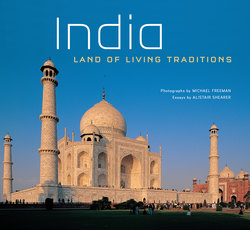Читать книгу India: Land of Living Traditions - Alistair Shearer - Страница 7
На сайте Литреса книга снята с продажи.
ОглавлениеIntroduction
“The sole country under the sun that is endowed with imperishable interest…the one land all men desire to see, and having seen once, by even a glimpse, would not give that glimpse for the shows of all the rest of the globe combined.”
—Mark Twain, ninteenth-century
American writer and traveller.
India is not just another country—it is an extraordinary adventure. Nowhere else has the same power to ravage the senses, strain the credibility, expand the mind and open the heart as this teeming kaleidoscope of seeming contradictions, a land full of contrasts as legion as they are legendary. It is the living museum of the human mind; to journey here is to time travel among sights, beliefs and practices that have long since disappeared elsewhere. Nothing is hidden in India. She is the land of dreams and tales, where travelling storytellers still mesmerize their village audiences, yet she is simultaneously the world’s biggest inventor of sophisticated computer software. A fabulous, ancient and stately civilisation, where respected feudal rulers still live in palaces and millions hold the cow sacred, India somehow manages to be the world’s largest democracy, which, while only 52 per cent literate, contains the world’s second largest pool of trained scientists and engineers.
Everywhere one looks in India, time-hallowed tradition meets the twenty-first century head-on in a dizzying cocktail of intense impressions. Peacocks sit imperiously atop satellite dishes; elephants and cows cause good-natured traffic jams; processions of naked ascetics amble past crowded cybercafes. All humanity seems to be on the move on India’s roads, where the latest Mercedes jostles with wooden bullock-carts designed five thousand years ago and painted trucks, vertiginously laden, lurch past brilliant swathes of cotton, silk and chillies spread out to dry in the scorching sun beneath impossible tangles of telephone wires. The city streets, sizzling with entrepreneurial energy, are packed with people, yet beyond the cities lie the somnolent villages where seven out of every ten Indians live and time hangs suspended; beyond them again stretch tranquil forests and silent deserts where wild animals still reign.
India’s uniqueness has attracted adventurers—merchants, poets, artists—for millennia; today’s tourists are merely the latest wave of visitors to stand and marvel. This is a civilisation that has suffered and absorbed innumerable foreign conquests, creating a a richly variegated tapestry of peoples and traditions, yet it is today facing perhaps the greatest threat to its survival. For traditionally India—and this is part of her fascination—has stood for values that are very different to those of the modern, secular West. She has believed that humanity is inextricably part of nature, not merely its exploiter; that human communities—family, tribe, caste—have enduring value, not just their individual members; that the worlds of the imagination, the hidden realms of gods, myths and magic, are just as real as the daylight world of history and science. Above all she has taught that we should lead a tolerant and balanced life in rhythms well-established, the goal of which is not merely to accumulate money, power and things, but to find God. In the brave new world of globalisation and the Internet, what is unique in India may not survive for long, yet it may be that she has things to teach us.
Scenes from the annual parade of painted elephants, just before the festival of Holi in the city of Jaipur.
Man Mandir Palace, Gwalior. Built between 1486 and 1517 by Raja Mansingh, the palace dominates Gwalior Fort, which stands on a steep mass of sandstone overlooking the city.
Cut into the sandstone cliffs below Gwalior Fort are a series of Jain statues. These are in the best-preserved southeast group.
The backwaters of Kerala, a labyrinth of canals surrounding Lake Vembanand. Many of the original rice barges known as kettuvallams (top) have been converted into houseboats.Village life (above) nevertheless continues, despite the growth of tourism.
A misty sunrise over harvested rice fields in the southern state of Tamil Nadu.
Farmers winnowing rice during the harvest following the monsoon rains in a village near Mamallapuram, south of Chennai.
Fatehpur Sikri, ‘the City of Victory,’ was built by the Mughal emperor Akbar in 15 years, starting in about 1569. Sheikh Salim Chishti’s white marble mausoleum is the jewel of the courtyard of the Friday Mosque.
The tomb of Itmad-ud-Daulah was built on the banks of the Yamuna River in Agra between 1622 and 1625. It includes many design features that were later used in the construction of the nearby Taj Mahal.
The Taj Hotel in Mumbai is one of the city’s enduring landmarks. Built in 1903, it was the first modern hotel in the city, then known as Bombay.
The Gateway of India, seen from the upper floors of the Taj Hotel, was completed in 1928 to celebrate the arrival of King George V and Queen Mary.
